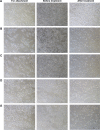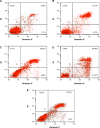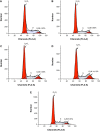Synthesis, characterization, and in vitro evaluation of curcumin-loaded albumin nanoparticles surface-functionalized with glycyrrhetinic acid
- PMID: 26346750
- PMCID: PMC4556296
- DOI: 10.2147/IJN.S88253
Synthesis, characterization, and in vitro evaluation of curcumin-loaded albumin nanoparticles surface-functionalized with glycyrrhetinic acid
Erratum in
-
Erratum: Synthesis, Characterization, and in vitro Evaluation of Curcumin-Loaded Albumin Nanoparticles Surface-Functionalized with Glycyrrhetinic Acid [Corrigendum].Int J Nanomedicine. 2021 Jun 29;16:4371-4372. doi: 10.2147/IJN.S322322. eCollection 2021. Int J Nanomedicine. 2021. PMID: 34234431 Free PMC article.
Abstract
We have designed and developed curcumin (Ccn)-loaded albumin nanoparticles (BNPs) surface-functionalized with glycyrrhetinic acid (Ccn-BNP-GA) for GA receptor-mediated targeting. Ccn-BNP-GA was prepared by conjugating GA as a hepatoma cell-specific binding molecule onto the surface of BNPs. Ccn-BNP-GA showed a narrow distribution with an average size of 258.8±6.4 nm, a regularly spherical shape, an entrapment efficiency of 88.55%±5.54%, and drug loading of 25.30%±1.58%. The density of GA as the ligand conjugated to BNPs was 140.48±2.784 μg/g bovine serum albumin. Cytotoxicity assay results indicated that Ccn-BNP-GA was significantly more cytotoxic to HepG2 cells and in a concentration-dependent manner. Ccn-BNP-GA also appeared to be taken up to a greater extent by HepG2 cells than undecorated groups, which might be due to the high affinity of GA for GA receptors on the HepG2 cell surface. These cytotoxicity assay results were corroborated by analysis of cell apoptosis and the cell cycle. Further, Ccn-BNP-GA showed an approximately twofold higher rate of cell apoptosis than the other groups. Moreover, proliferation of HepG2 cells was arrested in G2/M phase based on cell cycle analysis. These results, which were supported by the GA receptor-mediated endocytosis mechanism, indicate that BNPs surface-functionalized with GA could be used in targeted cancer treatment with high efficacy, sufficient targeting, and reduced toxicity.
Keywords: albumin; curcumin; glycyrrhetinic acid; nanoparticles; surface-functionalized.
Figures










Similar articles
-
Curcumin-loaded galactosylated BSA nanoparticles as targeted drug delivery carriers inhibit hepatocellular carcinoma cell proliferation and migration.Int J Nanomedicine. 2018 Dec 6;13:8309-8323. doi: 10.2147/IJN.S184379. eCollection 2018. Int J Nanomedicine. 2018. PMID: 30584302 Free PMC article.
-
Glycyrrhetinic acid-functionalized mesoporous silica nanoparticles as hepatocellular carcinoma-targeted drug carrier.Int J Nanomedicine. 2017 Jun 12;12:4361-4370. doi: 10.2147/IJN.S135626. eCollection 2017. Int J Nanomedicine. 2017. PMID: 28652738 Free PMC article.
-
Doxorubicin-loaded glycyrrhetinic acid modified recombinant human serum albumin nanoparticles for targeting liver tumor chemotherapy.Mol Pharm. 2015 Mar 2;12(3):675-83. doi: 10.1021/mp500394v. Epub 2015 Feb 5. Mol Pharm. 2015. PMID: 25584860
-
Glycyrrhetinic Acid Mediated Drug Delivery Carriers for Hepatocellular Carcinoma Therapy.Mol Pharm. 2016 Mar 7;13(3):699-709. doi: 10.1021/acs.molpharmaceut.5b00677. Epub 2016 Jan 25. Mol Pharm. 2016. PMID: 26808002 Review.
-
Recent Advances in Glycyrrhetinic Acid-Functionalized Biomaterials for Liver Cancer-Targeting Therapy.Molecules. 2022 Mar 8;27(6):1775. doi: 10.3390/molecules27061775. Molecules. 2022. PMID: 35335138 Free PMC article. Review.
Cited by
-
Polymeric Nano-Micelles as Novel Cargo-Carriers for LY2157299 Liver Cancer Cells Delivery.Int J Mol Sci. 2018 Mar 6;19(3):748. doi: 10.3390/ijms19030748. Int J Mol Sci. 2018. PMID: 29509706 Free PMC article.
-
Construction of pH-sensitive targeted micelle system co-delivery with curcumin and dasatinib and evaluation of anti-liver cancer.Drug Deliv. 2022 Dec;29(1):792-806. doi: 10.1080/10717544.2022.2048132. Drug Deliv. 2022. PMID: 35261298 Free PMC article.
-
A Glycyrrhetinic Acid-Modified Curcumin Supramolecular Hydrogel for liver tumor targeting therapy.Sci Rep. 2017 Mar 10;7:44210. doi: 10.1038/srep44210. Sci Rep. 2017. PMID: 28281678 Free PMC article.
-
Novel multifunctional pH-sensitive nanoparticles loaded into microbubbles as drug delivery vehicles for enhanced tumor targeting.Sci Rep. 2016 Jul 5;6:29321. doi: 10.1038/srep29321. Sci Rep. 2016. PMID: 27378018 Free PMC article.
-
Curcumin-loaded galactosylated BSA nanoparticles as targeted drug delivery carriers inhibit hepatocellular carcinoma cell proliferation and migration.Int J Nanomedicine. 2018 Dec 6;13:8309-8323. doi: 10.2147/IJN.S184379. eCollection 2018. Int J Nanomedicine. 2018. PMID: 30584302 Free PMC article.
References
-
- Hu CM, Zhang L. Nanoparticle-based combination therapy toward overcoming drug resistance in cancer. Biochem Pharmacol. 2012;83(8):1104–1111. - PubMed
-
- Zhang X, Guo S, Fan R, et al. Dual-functional liposome for tumor targeting and overcoming multidrug resistance in hepatocellular carcinoma cells. Biomaterials. 2012;33(29):7103–7114. - PubMed
-
- Zhang XJ, Zhang XG, Yu PE, Han YC, Li YG, Li CX. Hydrotropic polymeric mixed micelles based on functional hyperbranched polyglycerol copolymers as hepatomatargeting drug delivery system. J Pharm Sci. 2013;102(1):145–153. - PubMed
-
- Xun S, Fang W, Wei L, Zhang ZR. Sustained-release hydroxycamptothecin polybutylcyanoacrylate nanoparticles as a liver targeting drug delivery system. Pharmazie. 2004;59(10):791–794. - PubMed
Publication types
MeSH terms
Substances
LinkOut - more resources
Full Text Sources

